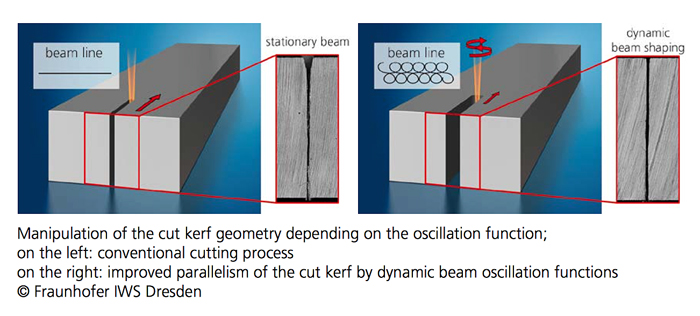27 Oct 2016
Fraunhofer IWS (Dresden) optimizes fusion cutting to improve cut quality in thick metal sheets. Demo at this week’s EuroBLECH show.

Fraunhofer IWS, in Dresden, Germany, is working on innovative solutions for the optimization of laser beam fusion cutting processes which result in an improved cutting quality. The IWS developers contend that the “leading position” of the solid state laser as universal laser beam source for the cutting market can be extended.
Two key areas of R&D by Fraunhofer IWS in the field of laser beam cutting are: the qualification of innovative cutting methods such as remote laser cutting for industrial production; and the development of laser beam fusion cutting. These aims are supported by fundamental investigation to better understand the nature of these processes. The IWS scientists are working with established laser types operating at different wavelengths, powers and beam qualities in combination with what they call “highly dynamic 2D and 3D cutting machines”.
Dynamic beam shaping
Alongside commercially available optical equipment for the focusing and the shaping of the beam, special-purpose solutions and equipment developed in-house are used as well. Additionally, there are numerous possibilities for the characterization of the process results, from roughness measurement at the cutting edge to detection of magnetic properties at laser cut electrical steel sheets.
At this week’s EuroBLECH trade fair in Hannover, Germany, the IWS scientists presented a new approach to cutting thick metal sheets by the means of dynamic beam shaping. The basic idea is to modify the spatial and temporal energy deposition so that the advantages of high focal intensities remain while the absorption increases. See optics.org’s further coverage of EuroBLECH here.
For this purpose, a standard cutting head is combined with a high performance scanner system. A specially-designed control solution allows for the programming of freely-definable functions of the scanner system in the kilohertz range. Numerous degrees of freedom modulate the oscillation of the laser beam and add possibilities to the conventional cutting parameters such as laser power, feed rate, focal plane, and gas pressures.
Without requiring physical adaptation of the beam’s focal length as is done with standard cutting machines, the IWS development says that “very good cutting performances for thin and thick metal sheets are achieved with the same focal length”. The new process integrated sensor systems also allows efficient customer-specific optimization of the cutting process.
IWS is exhibiting this technology, among others, at EuroBLECH trade fair to October 29, in Hannover at the Fraunhofer stand in hall 11 / B135.
| © 2026 SPIE Europe |
|